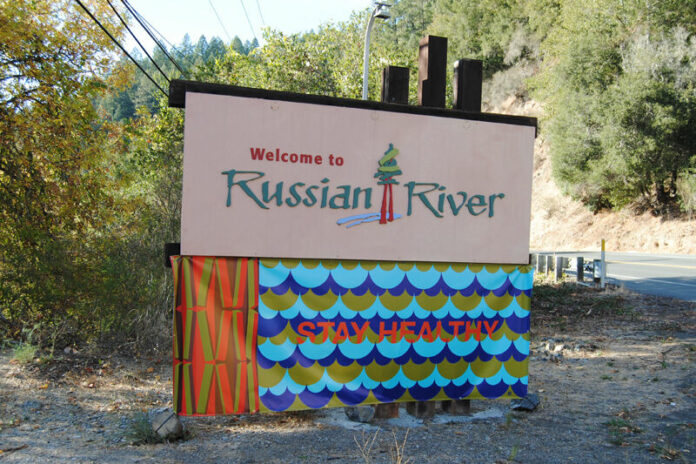Welcoming messages for businesses and principles of pandemic safety have arrived in a series of art installations throughout the Russian River area by Jim Isermann, part-time local and world-famous artist. The project was a business match made in a diner for Bob Pullum, creative director of the “Creative ReOpening Project” of the Russian River and Monte Rio Chambers of Commerce.
Isermann had designed the new ceiling of Pat’s International, a restaurant in downtown Guerneville, Pullum said. “He created this amazing vacuum-form ceiling that sort of changes color like an LED lighting system.”
Pullum, who owns the Guerneville Bank Club, said he researched more of Isermann’s work and sought a partnership because he felt the project he had in mind needed visuals that could unify a region and stand out like Isermann’s graphics that often involve conforming large patterns to large spaces.
And he’s international, alright. Isermann’s work has seen the gallery lights of Praz-Delavallade, Paris and Corvi-Mora, London, according to his website. From Artforum International Magazine to the Palm Springs Museum of Art, Isermann frequently works in modules of geometric patterns that repeat and find a home within the architecture.
“A lot of what I do deals with pattern and repetition and there’s often some site specificity to the pattern in the public works that I do,” Isermann said. “And so, when Bob reached out to me, I wanted to come up with new patterns that had some relationship to the Russian River.”
He lives in Palm Springs half the year as a professor at UC Riverside teaching mostly sculpture and spends the summer months and holidays in the cabin in Guerneville he bought ten years ago.
Isermann said Pullum’s offer was a chance to do something supportive for the Russian River community. He said his patterns usually aren’t as representative as the two originals he created for the project, based on river water wavelets and the bark structure of a redwood tree.
But redwoods have a special place in Isermann’s heart, walking his 90-pound, probable pinscher-pitbull mix named Happy every morning in Armstrong Woods when he’s in town.
“So, I’d been looking at that kind of very distinctive pattern of that bark for years. When they asked me to think about this project, every morning I’d be walking the dog, taking pictures of these trees in different light,” he said.
Isermann is back in Palm Springs now, stretching his stay in Guerneville as long as he could before he needed to return to the university. He said the original plan was to have the art up by Labor Day, but all initial projections flew out the window after a delay in funding. The Walbridge Fire forcing west county out of the forest didn’t help.
Isermann called Pullum one of the greatest people he’s ever collaborated with, despite the fact they never met face to face, and said he was someone who was willing to take on anything to make the project come to life.
They worked together conceptually to create over 50 iterations of Isermann’s original artwork for the project, now rippling across five miles in green, orange and blue conformed to storefront windows, sandwich boards, vinyl banners and more from Guerneville to Monte Rio.
Establishments could even receive Isermann’s designs on limited-edition masks produced by San Francisco company Open-Editions, according to a press release.
Pullum added the slogans featured in the art installations – “Be safe,” “Be smart,” “Be kind,” “Stay healthy” – from Sonoma County Tourism’s SAFE Travels Promise that debuted in May for visitors. Businesses could also opt for the slogan “social distance.”
“This was sort of the early days of the virus situation and the lockdown. So, when the county was able to, they (had) this material to distribute and hand out,” he said, having worked with the organization then.
Karin Moss, executive director of the Russian River Chamber of Commerce, said she joined forces with Marina McTaggart, president of the Monte Rio Chamber of Commerce, to clinch a grant for the “Creative ReOpening Project” from Creative Sonoma and the National Endowment for the Arts to contract Isermann and offer his installations to businesses at no cost, she said.
“The point of this is to improve awareness of social distancing and best practices during the pandemic, so to let people know — by drawing them into this really unique, upbeat, optimistic artwork — we’re open for business. Let’s visually unite our corridor of Sonoma County,” Moss said.
The window has closed for businesses to participate and the installations should all be in place by the weekend, according to Moss. The intent was “to create this Instagram-ready moment where people may want to do selfies and share them on social media,” she said.
Moss said the Russian River area needed a unified artistic approach because state highways run through the region, unlike the other towns and cities hosting “Creative ReOpening Projects” through Creative Sonoma.
Healdsburg, Windsor, Santa Rosa, Petaluma and Sonoma Valley businesses can more freely expand their footprint by spilling out into the street and sidewalk, while west county towns would need to negotiate such expansions with Caltrans, she said.
“This needed to be turned around immediately,” Moss said. “It was, ‘How can the restaurants bounce back from not being able to serve indoors?’”
The installations grace Russian River business districts in November as coronavirus remains widespread in Sonoma County. So long as the county lingers in the purple tier, the state’s strictest category, dine-in restaurants are limited to outdoor and takeout service and retail and grocery stores operate at reduced capacity, according to state and county health departments.
50.7
F
Healdsburg
April 18, 2025








